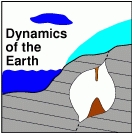- Kaufmann, G., Romanov, D., and Nielbock, R. :
Cave detection using multi-geophysical methods:- The Unicorn Cave, Harz Mountains, Germany
- Geophysics, 76(3), B71-B77, 2011.

| 65. |
| Cave detection using multi-geophysical methods: The Unicorn Cave, Harz Mountains, Germany |
| Georg Kaufmann1, Douchko Romanov1 Ralf Nielbock2 |
| 1Institute
of Geological Sciences, Free University Berlin, 12249 Berlin,
Germany 2Gesellschaft Unicornu fossile eV, Im Strange 12, 37520 Osterode am Harz, Germany |
| Geophysics, 76(3), B71-B77, 2011. |
|
Unicorn cave in the southern Harz Mountains of Germany is a show cave in dolomitic rocks of the Zechstein Formation. The cave¿s trunk passage is interrupted by larger rooms. The overburden is only around 15 m. The passages are filled with sediments that can be up to 50 m thick. We used gravimetry and electrical resistivity imaging over the cave area to identify the subsurface voids and the extent of the sediment infill of the cave passages. Our choice of methods was based on several conditions unique to the cave: (1) well surveyed, (2) shallow overburden, (3) large air-filled passages, and (4) thick sediment cover, concealing true passage size. Using the cave survey as an initial model for the subsurface structure, we successfully identified the air-filled cave with both methods. We then inferred the thickness of the sediment infill by forward modeling and identified a possible southward continuation beyond the currently explored passages. |